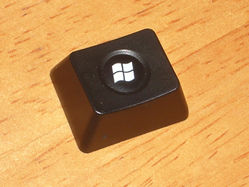Windows key
 | |
| Names | Windows logo key, Windows key, Start key |
|---|---|
The Windows logo key[1], abbreviated to Windows key, is a modifier key introduced by Microsoft to correspond with the introduction of Windows 95. The key serves a dual purpose under Microsoft Windows of behaving both as a function key and a modifier: when pressed, it opens the Start menu (or screen), and when held, it functions as a modifier key.
The Windows key introduced a series of global shortcuts such as Windows+E to open a new Explorer window, Windows+R to open the Run dialog box, and later Windows+L to lock your computer when you step away from your desk. The shortcuts have increased with successive versions of Windows.
In Windows, the Start Menu can also be brought up by pressing Control + Escape, in case the keyboard does not have a proper Windows key.
Contents
Windows Lock key
The Windows key has gained notoriety for escaping out of full-screen applications, which interrupts the playing of games. When a program is running full screen, pressing the Windows key will minimise it in order to display the Start menu (or Start screen), which is a highly disruptive behaviour.
For this reason, some keyboards for the gaming market have a Windows Disable function on a Windows Lock key. Examples of such keyboards include the Cooler Master QuickFire Rapid and Cherry G80-3850.
Non-Windows systems
In the USB "Human Interface Device" standard for keyboards, the scancodes for the two Windows keys are named "GUI".
Macintosh
On Macintosh, the keys are the same as the left and right Command keys, but on keyboards designed for Macintosh, the order of the Command and Alt/Option keys is reversed from how they are on keyboards designed for PCs. Some keyboards therefore have a hardware setting (such as a DIP switch) for swapping them. It is also possible to switch them in the keyboard settings in MacOS.
Sun
Sun Microsystems was together with Microsoft and Apple one of the three early adopters of the USB protocol. Keyboards Sun Type 6 and Type 7 have the GUI code produced by the "Meta" key with the symbol ◆.
Linux
Under Linux, the keys are most often mapped to left and right Super keys.
In the desktop environments GNOME version 3 and Ubuntu's Unity, the Super keys are set up to activate program launchers similar to Windows' Start menu/screen.
Design
The appearance of the Windows logo key has changed as the Windows logo itself has changed. Originally, it was a hollow, monochrome representation of the Windows 95 logo. Starting with Windows XP, it changed into a monochrome representation of the Windows XP logo. With Windows Vista, the logo was required to be placed into a raised "bubble" within the keycap, which can be distinctly felt when pressing the key. Windows 8 introduced a new logo again.
Gallery
Windows 95–style keycap from a 2010 Unicomp Spacesaver
Windows Vista–style keycap from a 2010 Filco Majestouch
Windows 8–style keycap from a 2012 Dell KB522 multimedia keyboard
Hardware button
Keyboardless tablet PCs made for MS Windows often come with a button sporting the Windows logo. While this key does open up the Start screen when pressed, it is not equivalent to a proper Windows key. None of the regular Windows-key shortcuts work together with a separate keyboard. Unlike with the Windows key, holding the Windows button and pressing the power button brings up a Shutdown menu.
See also
External links
- Windows key on Wikipedia. Has a list of Windows-key combination per Windows version.
- Reddit—Hidden Windows Key Hotkeys. Unofficial additional key combinations supported by Windows 10.
References
- ↑ Microsoft — Keyboard shortcuts in Windows - Windows Help


